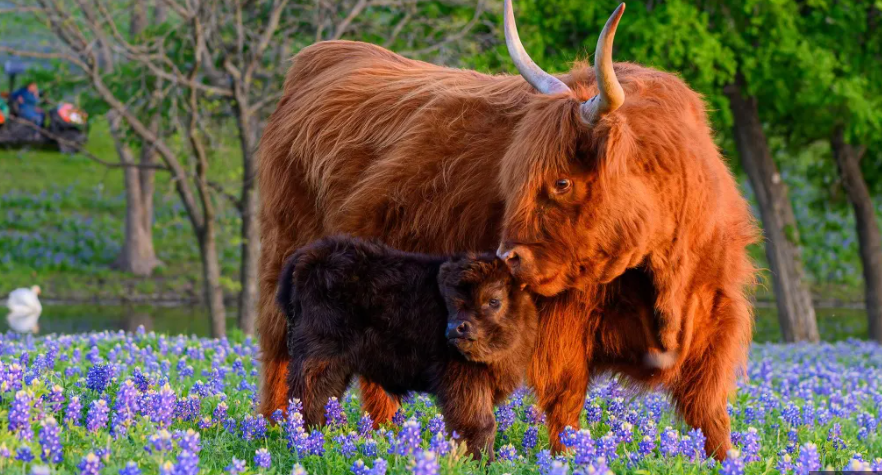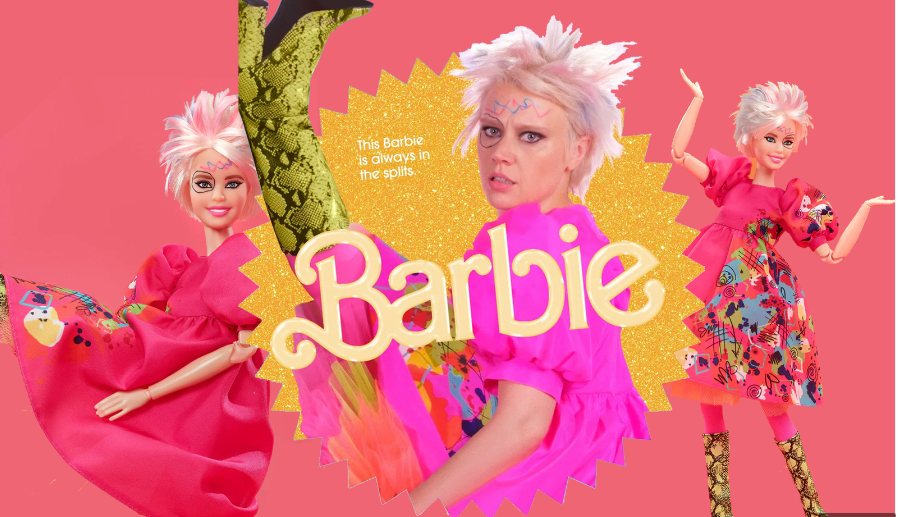The Highland cow is one of the most recognizable and cherished emblems of Scottish heritage. It is commonly referred to as the “Heilan’ coo” in Scotland. Known for their unique horns and long, shaggy coats, these magnificent animals have captured the imaginations of both locals and tourists. These Scottish Highland cows, whose origins are in rough terrain, are not only a beautiful sight, but also an example of how resilient and adaptive nature can be. Let’s explore the unique features of the Highland cow, including its origins, traits, and social and cultural roles within Scottish agriculture and society.
Highland cows are easily identified by their characteristic horns and long, woolly coats that are wavy and frequently referred to as fluffy. A range of hues, such as red, black, dun, yellow, white, grey, tan, silver, and brindle, are possible for their coats. The main reason these cows are grown is for their meat, which is in high demand due to its reduced cholesterol content than other beef varieties.
The robust breed of Highland cattle is well-suited to endure the severe weather seen in the Scottish Highlands. They are the only breed of cattle with a double coat of hair, consisting of a soft, downy undercoat underneath an elongated, oily outer layer. While cows can weigh as much as 500 kg, bulls can weigh an amazing 800 kg. Their milk is renowned for having a very high butterfat percentage as well.
Their characteristic long hair protects their eyes from pests, keeps them warm in the winter, and keeps brush and vegetation out of their way. They are quite well-liked because of their gorgeous appearance, which is greatly enhanced by their hair. Their hair gets shorter in the summer, especially if they are reared in a southern region. Highland cattle are naturally leaner since they do not need to store the extra fat that some other breeds do because of their long hair.
Historical Background
One of the oldest recorded breeds of cattle, the Highland cow has a history that dates back to the sixth century. It is thought that early Celtic settlers carried them to Scotland. The smaller, black cattle from the Western Isles and the larger, red cattle from the mainland were the two separate breeds at first. These two breeds mixed over time to become the modern Highland cow, which comes in a variety of colours including black, red, brindle, yellow, white, and dun.
These cattle were bred mainly for their meat and milk, and because of their hardiness, they adapted well to the rough, hilly landscape of the Highlands. For ages, Scottish farmers have valued them much due to their resilience to harsh weather and their adeptness in gathering food from the wild.
Physical Characteristics
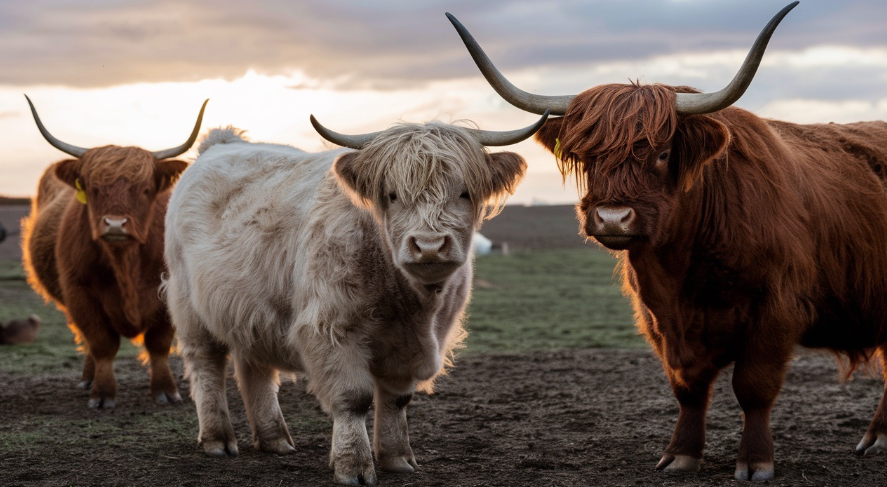
The long, thick coat of the Highland cow, which effectively insulates against the cold and damp weather typical of the Scottish Highlands, is its most notable characteristic. This coat has two layers: an oiled, long outer coat that helps keep out snow and rain, and a dense, woolly undercoat. The coat’s length and texture change with the seasons; in order to give more warmth, it gets longer and thicker in the winter.
Another differentiating feature of Highland cows is their tall, curving horns, which can grow up to three feet in diameter. In the winter, these horns are useful for both defence against predators and for breaking through the snow to acquire food. Males, or bulls, typically have bigger, more forward-facing horns, whilst females, or cows, have finer, more upright horns.
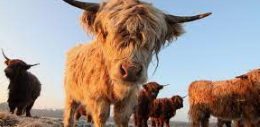
Their strong construction is another noteworthy aspect. Highland cows are medium-sized cattle; the weight range for bulls is 1,800–2,000 pounds, and the weight range for cows is 1,100–1,500 pounds. Their large body and small legs help them stay balanced and stable on rough, uneven terrain. Their characteristic fringe, known as a dossan, adorns their faces and serves as eye protection from insects and inclement weather.
Behaviour and Adaptability
Despite their intimidating appearance, Highland cows are noted for their mild and docile disposition, which makes them easy to handle. They are gregarious animals with strong parental instincts that usually dwell in herds. Cows are vigilant, protective moms who are frequently observed lovingly tending to their young.
The adaptability of Highland cows is among its most amazing qualities. From the chilly, rainy Scottish Highlands to the more temperate temperatures seen elsewhere in the world, they may survive in a variety of settings. They are well-insulated by their thick coat, which shields them from the wind and rain and helps them retain body heat in cold weather. Highland cows’ extraordinary capacity to adapt to varying temperatures is demonstrated by the fact that they will shed a large portion of their heavy coat in warmer locations in order to stay cool.
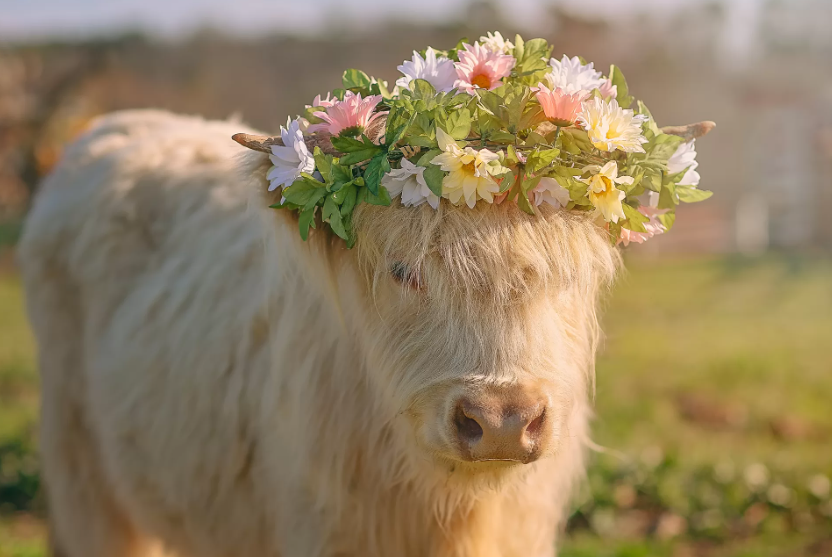
Highland cows are excellent foragers as well. They can graze on a variety of plants that other cattle might avoid, such as prickly plants, shrubs, and grasses. since of their diet’s versatility, they thrive in areas with little greenery since they can find food where other cattle might not be able to.
Highland Cow Milk
Small-scale milking of Highland cows can produce enough milk for individual consumption as opposed to large-scale production. A single cow may yield about two gallons a day on average. Some farmers find their milk’s exceptionally high butterfat content—which can reach up to 10%—appealing, but others might find it to be an acquired taste. In addition, compared to other cattle breeds, Highland cows have substantially smaller teats.
Role in Agriculture
For generations, people have kept Highland cows for their meat, which is prized for its superior quality. Compared to other beef breeds, Highland beef is more tasty, lean, and low in cholesterol. This makes it a well-liked option for those who value flavour and wellness. Because they may be raised in places unsuitable for other livestock, cows are an efficient and sustainable option for farmers. They can also feed on uneven terrain and low-quality flora.
Highland cows contribute to land management in addition to producing meat. Their grazing practices encourage biodiversity and avoid overgrowth, which both contribute to the landscape’s continued health. They aid in the management of invasive species and promote the development of native flora by grazing on a range of plants. Because of their advantages for the environment, they are used in conservation grazing programs, where they support the sensitive ecosystems’ delicate equilibrium.
Cultural Significance
Highland cows are more than just farm animals; they represent the pride and legacy of Scotland. Their picture, which captures Scotland’s untamed beauty and resilient spirit, is frequently utilised in branding and marketing campaigns. They represent the untamed and wild spirit of the Highlands and can be found in literature, art, and travel goods.
Also the cows appear in a number of festivals and cultural events. One of Scotland’s most important agricultural festivals, the Royal Highland Show, celebrates the nation’s rich farming heritage by showcasing Highland cows among other livestock. Travellers from all over the world come to see these amazing animals and discover more about their significance and history.
How to looks Highland Cows
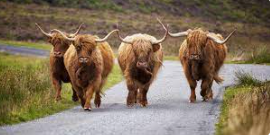
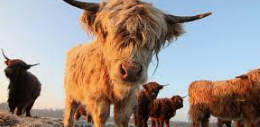
Highland cattle are frequently groomed with oils and conditioners for show purposes, giving their coats a fluffy look similar to that of their calves. They are referred to as “fluffy cows” with affection thanks to this grooming method.
Highland cattle are thought to be low-stress to maintain and handle because of their peaceful disposition and lack of hostility. They don’t fight because they understand the importance of social hierarchy within their herds. They also like socialising with people, frequently approaching walkers to be petted.
Conclusion
The essence of the Scottish Highlands is personified by the distinctive and iconic breed known as the Highland cow. These cows, with their unique physical attributes, kind disposition, and incredible flexibility, have gained a particular place in both agriculture and society. They still have a significant impact on farming methods, producing meat of the highest calibre and aiding in the sustainable management of land. In addition to their usefulness, Highland cows are a universal symbol of Scotland’s enduring legacy and natural beauty, capturing the hearts and imagination of people everywhere. As much as we value the distinctive qualities of Scotland’s national animal, we also understand how crucial it is to celebrate and preserve this amazing species for coming generations.
